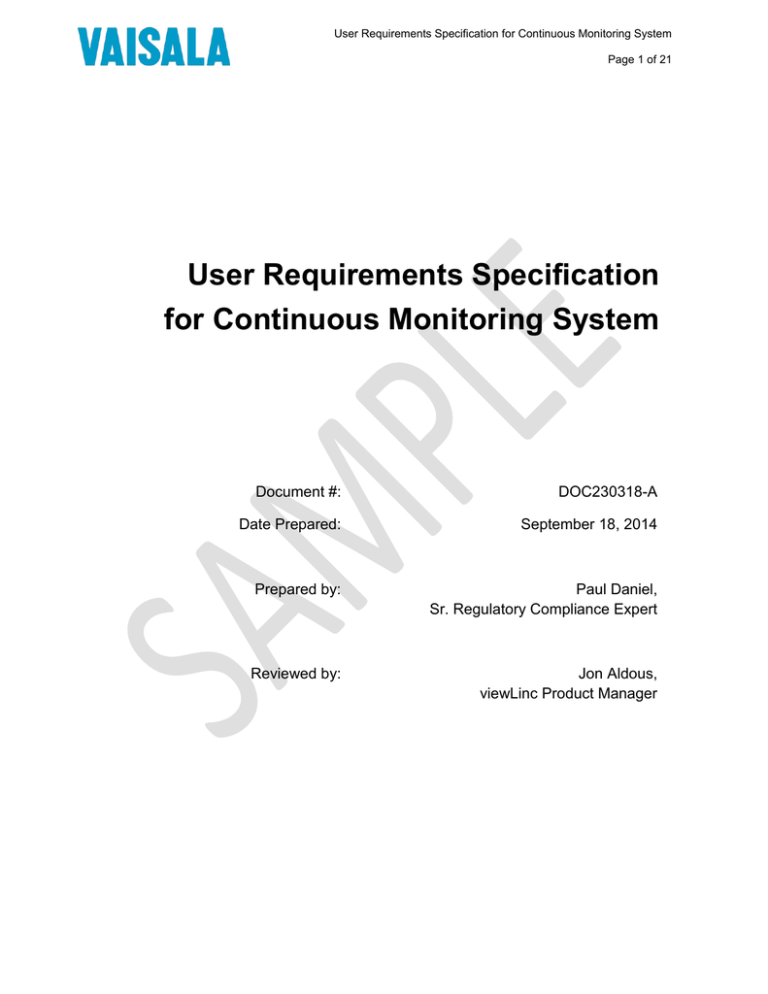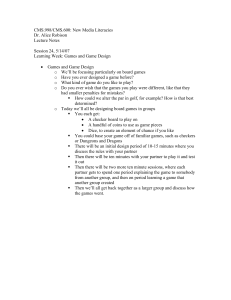
User Requirements Specification for Continuous Monitoring System
Page 1 of 21
User Requirements Specification
for Continuous Monitoring System
Document #:
DOC230318-A
Date Prepared:
September 18, 2014
Prepared by:
Paul Daniel,
Sr. Regulatory Compliance Expert
Reviewed by:
Jon Aldous,
viewLinc Product Manager
User Requirements Specification for Continuous Monitoring System
Page 2 of 21
DOCUMENT APPROVAL
Approved by:
Initials:
Date:
Initials:
Date:
Initials:
Date:
Initials:
Date:
Name (Print):
Title:
Company:
Approved by:
Name (Print):
Title:
Company:
Approved by:
Name (Print):
Title:
Company:
QA Approved by:
Name (Print):
Title:
Company:
© 2014 Vaisala
User Requirements Specification for Continuous Monitoring System
Page 3 of 21
Important Information
This document is intended to be edited and added to by the customer.
At certain places in this document there is [GREEN TEXT] which is for guidance only and
should be deleted prior to final publishing and approval.
At certain places in this document there is also [BLUE TEXT] which requires that information
be entered, usually a name, location, or configuration selection.
If changes are made, it is IMPERATIVE that the numbering sequence be maintained.
If a section is not required in the document, do not DELETE it. Replace the text with N/A and be
sure to maintain the numbering sequence.
o
To do otherwise will break the traceability between the documents.
Text may be added to the document in the form of new sections, but it must always preserve the
existing numbering.]
This page may be deleted if desired.
Vaisala
Tel: +1 (604) 273-6850
Fax: +1 (604) 273-2874
Toll-free in North America: 1-888-VAISALA
Email: helpdesk@vaisala.com
Web: www.vaisala.com/en/lifescience
© 2014 Vaisala. All rights reserved. Product and company names listed in this document are
trademarks or trade names of their respective companies.
© 2014 Vaisala
User Requirements Specification for Continuous Monitoring System
Page 4 of 21
Table of Contents
1
Purpose ................................................................................................................................................... 5
2
Scope....................................................................................................................................................... 5
3
Responsibilities ...................................................................................................................................... 5
4
Definitions ............................................................................................................................................... 5
5
Project Approach.................................................................................................................................... 6
6
System Description ................................................................................................................................ 6
7
User Requirements................................................................................................................................. 6
7.1 Server and Network Requirements (NET) ....................................................................................... 6
7.2 Sensor Management Requirements (SMA) ..................................................................................... 8
7.3 Software Application Requirements (APP) ...................................................................................... 9
7.4 Mobile GUI Requirements (MOB) .................................................................................................. 10
7.5 Data Thresholds Requirements (DTH) ........................................................................................... 10
7.6 Alarming Requirements (ALM) ....................................................................................................... 11
7.7 Reporting Requirements (REP) ..................................................................................................... 13
7.8 Security Requirements (SEC) ........................................................................................................ 15
7.9 Performance Requirements (PRF)................................................................................................. 16
7.10 Documentation Requirements (DOC) ............................................................................................ 17
7.11 Electronic Records Requirements (ELR) ....................................................................................... 17
7.12 Sensor Application Requirements (SAP) ....................................................................................... 18
7.13 Additional Requirements ................................................................................................................ 20
© 2014 Vaisala
User Requirements Specification for Continuous Monitoring System
Page 5 of 21
1
Purpose
The purpose of this User Requirements Specification (URS) is to define the User
Requirements for the Continuous Monitoring System (CMS) at the [LOCATION] facility of
[COMPANY NAME] company.
2
Scope
This document applies only to the Continuous Monitoring System (CMS) at the [LOCATION]
facility of [COMPANY NAME] company. [PLEASE MODIFY THIS SECTION AS
NECESSARY IF YOU ARE IMPLMENTING THIS SYSTEM AT MULTIPLE SITES.]
3
Responsibilities
[ENTER RESPONSIBILITIES AS APPROPRIATE]
4
Definitions
The following definitions are directly applicable to this project. [ADD ANY ADDITIONAL
DEFINITIONS OR MODIFY THE DEFINITIONS AS NECESSARY. DELETE ANY
UNUSED LINES IN THE TABLE.]
Term
Definition
CMS
Continuous Monitoring System
URS
User Requirements Specification
FS
Functional Specification
TM
Traceability Matrix
PoE
Power over Ethernet
CPU
Central Processing Unit
RAM
Random Access Memory
LAN
Local Area Network
OS
Operating System
ES
Enterprise Server
TCP/IP
Transmission Control Protocol / Internet Protocol
CAT 5
Category 5 (Network Wiring Standard)
SMS
Short Message Service
RTD
Resistance Temperature Detector
UTC
Coordinated Universal Time
IEEE
Institute of Electrical and Electronics Engineers
SMTP
Simple Mail Transfer Protocol
© 2014 Vaisala
User Requirements Specification for Continuous Monitoring System
Page 6 of 21
5
5.1
Project Approach
The CMS will be selected and implemented following Good Automated Manufacturing
Practices (GAMP), with the following steps/documents:
User Requirements Specification
Functional Specification
Risk Assessment
Testing
Traceability Matrix
6
System Description
6.1
The CMS will be implemented at the [LOCATION] facility of [COMPANY NAME]
company. The system is intended to monitor environmental parameters, such as
temperature and humidity, to ensure product quality. The specifications in this document
describe the required features and functions for the CMS. It is assumed that the system will
be comprised of sensors in field locations which supply data to a central server-based
software application that will store the data, and provide reporting and alarming capabilities.
6.2
Requirements in this specification will be organized into the following functional groups:
Server and Network - NET
Sensor Management - SMA
Software Application - APP
Mobile GUI (Graphical User Interface) - MOB
Data Thresholds - DTH
Alarming - ALM
Reporting - REP
Security - SEC
Performance - PRF
Documentation - DOC
Electronic Records - ELR
Sensor Applications - SAP
7
7.1
User Requirements
Server and Network Requirements (NET)
The following table details the requirements for server and network components of the CMS.
ID
Description
NET-01
The CMS must be an Enterprise-level system that can be accessed by multiple
simultaneous users in different locations at [FACILTY NAME], and at multiple facilities of
[ENTERPRISE NAME].
NET-02
The CMS must use only a single server to fulfill the roles of Web Server, Application
Server, Database Server, and Reporting Server, in order to minimize hardware costs,
license fees, and administrative duties, and to simplify system architecture.
© 2014 Vaisala
User Requirements Specification for Continuous Monitoring System
Page 7 of 21
ID
Description
NET-03
The CMS must run continuously without requiring regular downtime.
NET-04
The CMS must be capable of utilizing a [PHYSICAL / VIRTUAL] server for deployment.
NET-05
The CMS must utilize the existing [FACILITY NAME] Ethernet/Intranet for communication
with sensors and system users, and therefore must be compatible with TCP/IP (and IEEE
802.11 b/g if wireless) network standards.
NET-06
The CMS must not require a dedicated or proprietary software for system access. The
CMS must allow access by standard web-browser from [FACILITY NAME] Intranet
locations.
NET-07
The CMS must be compatible with the following web browsers: [Internet Explorer 8, 10,
and 11].
NET-08
The CMS must support secure communication (SSL).
NET-09
The CMS must be compatible with the [Microsoft Server 2003 (32-bit), Microsoft Server
2008 R2 (64-bit), Windows 7 Pro (64-bit), Microsoft Server 2012 R2 (64-bit)] operating
systems.
NET-10
The CMS must be installable in the following language(s): [English, French, German,
Swedish, Chinese, Spanish, Portuguese, Japanese].
NET-11
The CMS sensors must connect to the CMS server through one of the following methods:
[COM Port, USB Port, Serial network adapter, TCP/IP network connection (IP address)].
NET-12
The CMS must support SMTP (Simple Mail Transfer Protocol) for plain text email.
NET-13
The CMS must support the use of POP3 servers for email.
NET-14
The CMS must support ESMTP TLS email servers for secure email.
NET-15
The CMS must auto-select the highest email security level when sending emails.
NET-16
The CMS Server must have the necessary hardware (i.e., SMS modem) to send SMS
messages.
NET-17
The CMS must support the use of satellite servers (CMS Hosts) at other facility locations
to improve performance for large widely distributed systems.
NET-18
NET-19
NET-20
NET-21
© 2014 Vaisala



